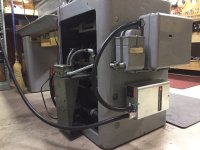"I use a VFD on my mill, lathe AND grinders. I've got tachs on all of them for fine tuning speed. That's very useful for grinding, and is nice for lathe work because I can bump the speed up as I'm roughing something down to smaller diameter or facing from large to small diameter, etc."
Attached are a couple of my Sheldon W-56-P lathe. This machine is running on a static converter. It has built-in push-button speed and directional controls in the original control console. The speed change is accomplished by an independent gear motor controlling a Worthington drive. There is no need to complicate things by adding a VFD. Granted this is a bit uncommon, but it works flawlessly.





